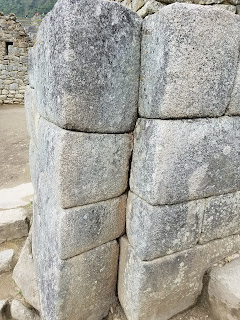After blindly wandering around yesterday in Machu Picchu, today we went the correct route and we're so enlightened. It's places like this where a private guide doubles your experience. We came in knowing some things about Machu Picchu but we really came away with a much better level of understanding. It was a walled city. Only the nobility lived inside. It was never a lost city and there are actually seven different entrances to it along different Inca Trails. Our guide was able to point them out for us on the distance mountains. However Hiram Bingham was a master marketer and he was able to bring Fame to the location by calling it a lost city. Different buildings had different levels of quality. The store houses had a rough-hewn more natural shaped rocks with smaller rocks placed in between. The next level was trapezoidal shape rocks and odd shaped rocks all put together very masterfully and finally the Imperial style had rectangular rocks that were uniform in size and fitted together almost perfectly. I must have taken a thousand pictures and I will try not to overwhelm you with all of them. But I will show you a variety of different things that we saw from an architectural point of view.

Leslie and our guide Leon
Terraces go all the way up the hill to the building on top. They were used for growing crops on the side of the mountain.
The trapezoidal style capped rocks in odd formations depending on how they were able to extract them from the quarry. No mortar was used
Sometimes the rocks cleave in nice orderly ways and sometimes not. When you are building a city, there are usually rocks to match.
This is more of the Imperial style. Where the rocks are uniformly squared off to the right size
a street between two buildings
Dewey's rocks were left protruding and we used to tie the roof beams to the building.
We are sitting on a large piece of rock. This rock was left inside the building and was actually showing marks of being quarried. Sometimes they would leave large rocks in as part of the foundation or as part of the building and sometimes they would just cut new pieces off of them as needed.
These cut out areas have been shown to actually help improve the flexibility of a building. That allows it to be more stable in an earthquake
This is from the highlight of the Imperial










